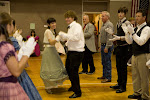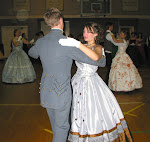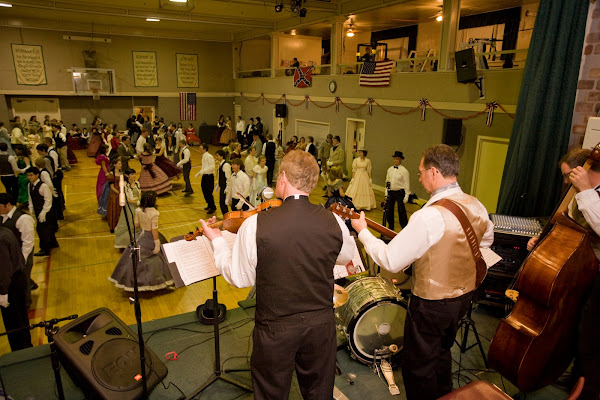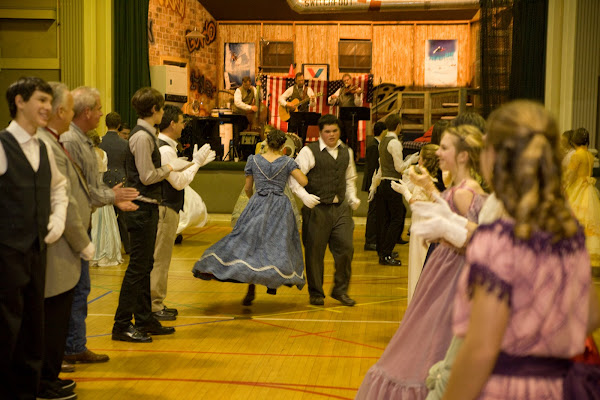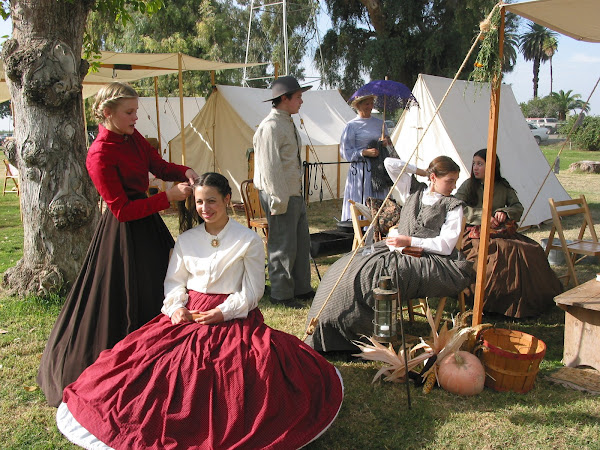“I’ve seen Pride and Prejudice, and I’ve seen Civil War movies, and the women are not modestly dressed. Why do you have such strict modesty standards for the Civil War Balls?” – A Civil War Ball attendee
That is a fair question, and one I hope to answer in this week’s blog. It is true that the women that you see in “period” movies to not appear to be modestly dressed by our modern standards. Necklines and hem lines have been going up and down for centuries. Even in the 20th century, the flappers of the Roaring Twenties were more scantily clad than the more conservative 1940’s ladies. People showed more skin in the 1960’s than they did in the 1980’s.
To a woman in the 1860’s, a low neckline was an indication of her femininity, and her sense of modesty would be horrified by a woman in pants… or even worse… shorts! It’s interesting to think about the fact that the part of the body a lady endeavored to keep covered at that time was her ankles.
In the book of Romans, Paul says that it is good not to do anything by which your brother stumbles or is offended or is made weak. Victorian Balls are social events with the purpose of dancing and talking with a variety of people. It is not comfortable for a gentleman to dance or speak with a lady if he feels he must constantly avert his eyes. We are at the balls to build community. Because there are people, particularly men but also children, who would be affected by loose modesty standards, we will always adhere to the rule of – No cleavage, no plunging necklines and no bare shoulders.
So we ask our ladies to dress modestly, knowing that, as it says in the 1828 Webster dictionary… “Modesty is the sweetest charm of female excellence, the richest gem in the diadem.*”
(*Diadem - badge of royalty, a crown)
What do I wear?
Our balls are formal events, and one of the challenges is to come up with modest, elegant attire that doesn’t impact the pocketbook too severely. At the first ball that our family attended, my oldest daughter and I wore old bridesmaid dresses that I had saved from when I was in my twenties. (Yes, I save everything.) My son and husband wore slacks with shirts and vests (only $3) that I had purchased at the thrift store. As we continued to attend more and more balls, my girls sometimes wore my high school prom dress. (See, I told you that I save everything) or something we had purchased at a thrift store or garage sale.
One of the most difficult and expensive ways of providing a lady with a dress for the ball is to purchase a hoop skirt and make a period appropriate dress. After several years, my girls and I eventually did do this.
Ideas for making or purchasing period costumes can be found at:
Timeless Stitches
Abraham's Lady
HOWEVER, there are other ways to come up with an appropriate long gown.
For the Ladies: Inexpensive dresses can be purchased at garage sales, thrift stores and off the clearance rack at Ross. But the problem with most of them is MODESTY.
I purchased a green satin gown at the thrift store several years ago that I am sure was someone’s bridesmaid dress. It was a little short on me and it had a plunging neckline, which is not acceptable at the balls. So I took a triangle of black satin material and put it in the front, and then made a strip of satin and sewed it along the bottom… and ta-da.. I was ready to go! I plan to wear it again at our Christmas Ball in December.
You can also cover spaghetti straps and low cut gowns in other ways. Period appropriate coverings include Fishus, Berthas, Shawls and Bolero Jackets.
A Bertha is a square or oval piece of material that goes over the top of the dress neckline. There is a picture and pattern for one at the Timeless Stitches website.
A Fishu is a long strip of material that goes around the back of the neck and shoulders, crosses in the front and then ties in the back. You can use a scarf or a shawl and tie it in this way so that it would not come off while you are dancing.
A Shawl – Most of us have shawls at home, even if we don’t often wear them. I have a couple crochet shawls that my grandmother made years ago. Even a large piece of lace would work. They are a little difficult to deal with at a ball unless you pin them securely. But with a couple of lovely pins secured in the right places, a shawl can be used to cover up an immodest dress.
A Bolero Jacket – A short jacket made of cloth or crocheted yarn with long or short sleeves works well as a ball gown addition. Our friend’s daughter found a black velvet Bolero Jacket to go with her forest green gown. It is quite lovely.
Simple Sewing - If you sew, you can make a simple skirt and top it with a pretty blouse and be ready to go.
 More Challenging Sewing - If you decide that you just can’t live without making yourself a period dress, you can take a look at Timeless Stitches. Simplicity also has some Civil War Ball gown patterns.
More Challenging Sewing - If you decide that you just can’t live without making yourself a period dress, you can take a look at Timeless Stitches. Simplicity also has some Civil War Ball gown patterns.
Rent - Perhaps this buying and sewing is more than you are willing to undertake at this time. You can always rent a costume for the evening.
1. Alesen Corella rents dresses and hoops at Family Theater Project.
2. Aimee Oliver rents dresses and hoops at Aimee's Armoire.
3. Colleen Canaan rents dresses, hoops and men's attire at Costume Connection in Atascadero. Contact her at 438-4635.
4. Costume Capers in San Luis Obispo (behind Smart and Final) rents dresses, hoops, and uniforms and tuxedos. Call 544-2373.
Expect to pay $30 to $60 for a dress and hoop rental.
And for the Gentlemen – A nice pair of slacks, a long sleeve button shirt and tie are things that you probably already own, and they are acceptable for the ball. However, a Victorian gentleman would not be seen without a vest or jacket, so if you want to take it up notch, you can go to a bridal shop and ask if they have any vests on clearance. I recently purchased two satin vests for my husband and son at a local bridal shop, and I bought my son an inexpensive tuxedo jacket. Vests and jackets can also be purchased at the thrift stores or rented at the locations listed above.
For Children – Many children dress in a similar fashion to the adults. I purchased flower girl dresses for my girls at garage sales when they were young. (Which I still have. Remember, I save everything.)
Shoes – For the ladies – dress in something comfortable. You will be on your feet most of the night and will be getting a lot of exercise. I wear a pair of Mary Jane style black Sketchers. Gentleman, comfortable dress shoes are best.
Gloves – Gloves are required for our Grand Balls. They lend an air of elegance to the event and cleanliness too. You can purchase vintage gloves at antique stores, and you can get regular gloves at uniform supply stores. At some Balls, you can get a pair of gloves for a suggested donation of $5.00.
I hope that helps you with your concerns about what to wear. Email me at cwdanceinfo@gmail.com if you have any questions!
One of the most difficult and expensive ways of providing a lady with a dress for the ball is to purchase a hoop skirt and make a period appropriate dress. After several years, my girls and I eventually did do this.
Ideas for making or purchasing period costumes can be found at:
Timeless Stitches
Abraham's Lady
And watch the videos on the Heritage Dance Events Website for more ideas.
HOWEVER, there are other ways to come up with an appropriate long gown.
 |
| This lace shawl is securely pinned so that she can dance the night away. |
I purchased a green satin gown at the thrift store several years ago that I am sure was someone’s bridesmaid dress. It was a little short on me and it had a plunging neckline, which is not acceptable at the balls. So I took a triangle of black satin material and put it in the front, and then made a strip of satin and sewed it along the bottom… and ta-da.. I was ready to go! I plan to wear it again at our Christmas Ball in December.
 |
| My Green Satin Dress |
 |
| This is a great Fishu over a spaghetti strap dress. |
A Fishu is a long strip of material that goes around the back of the neck and shoulders, crosses in the front and then ties in the back. You can use a scarf or a shawl and tie it in this way so that it would not come off while you are dancing.
 |
| Here's the back of the Fishu |
A Shawl – Most of us have shawls at home, even if we don’t often wear them. I have a couple crochet shawls that my grandmother made years ago. Even a large piece of lace would work. They are a little difficult to deal with at a ball unless you pin them securely. But with a couple of lovely pins secured in the right places, a shawl can be used to cover up an immodest dress.
A Bolero Jacket – A short jacket made of cloth or crocheted yarn with long or short sleeves works well as a ball gown addition. Our friend’s daughter found a black velvet Bolero Jacket to go with her forest green gown. It is quite lovely.
Simple Sewing - If you sew, you can make a simple skirt and top it with a pretty blouse and be ready to go.
 More Challenging Sewing - If you decide that you just can’t live without making yourself a period dress, you can take a look at Timeless Stitches. Simplicity also has some Civil War Ball gown patterns.
More Challenging Sewing - If you decide that you just can’t live without making yourself a period dress, you can take a look at Timeless Stitches. Simplicity also has some Civil War Ball gown patterns.Rent - Perhaps this buying and sewing is more than you are willing to undertake at this time. You can always rent a costume for the evening.
1. Alesen Corella rents dresses and hoops at Family Theater Project.
2. Aimee Oliver rents dresses and hoops at Aimee's Armoire.
3. Colleen Canaan rents dresses, hoops and men's attire at Costume Connection in Atascadero. Contact her at 438-4635.
4. Costume Capers in San Luis Obispo (behind Smart and Final) rents dresses, hoops, and uniforms and tuxedos. Call 544-2373.
Expect to pay $30 to $60 for a dress and hoop rental.
And for the Gentlemen – A nice pair of slacks, a long sleeve button shirt and tie are things that you probably already own, and they are acceptable for the ball. However, a Victorian gentleman would not be seen without a vest or jacket, so if you want to take it up notch, you can go to a bridal shop and ask if they have any vests on clearance. I recently purchased two satin vests for my husband and son at a local bridal shop, and I bought my son an inexpensive tuxedo jacket. Vests and jackets can also be purchased at the thrift stores or rented at the locations listed above.
For Children – Many children dress in a similar fashion to the adults. I purchased flower girl dresses for my girls at garage sales when they were young. (Which I still have. Remember, I save everything.)
Shoes – For the ladies – dress in something comfortable. You will be on your feet most of the night and will be getting a lot of exercise. I wear a pair of Mary Jane style black Sketchers. Gentleman, comfortable dress shoes are best.
Gloves – Gloves are required for our Grand Balls. They lend an air of elegance to the event and cleanliness too. You can purchase vintage gloves at antique stores, and you can get regular gloves at uniform supply stores. At some Balls, you can get a pair of gloves for a suggested donation of $5.00.
I hope that helps you with your concerns about what to wear. Email me at cwdanceinfo@gmail.com if you have any questions!
Manners
“It’s not about you.” – Rick Warren
This quote, from the first chapter of Rick Warren’s best selling book The Purpose Driven Life, comes as a shocking revelation to much of society. But those of us who use the Bible as the fundamental guide for social conduct find that we are to “let no one seek his own, but each one the other’s well being.” And also, “let each of us please his neighbor for his good, leading to edification (building up).”
Building community is one of our missions at our Civil War Balls, and one of the ways we do this is to encourage each participant to treat everyone in attendance with kind manners and proper etiquette.
Victorian Balls were social events where service, respect and honor were practiced. They were held so that guests could have the opportunity to dance and talk with a variety of people. In the 1800’s there would have been people from various ranks of life in attendance – Colonels and tradesmen, old and young, beautiful and not-as-beautiful. But from the perspective of social responsibility, it didn’t matter. At the ball, then and now, a gentleman has the responsibility to dance with a variety of ladies, and the ladies have the responsibility to accept if asked.
So how do we begin? When entering a ballroom, a well-bred person smiles and bows or curtseys in greeting. They address the guests by respectful titles such as Sir or Madam, and they use words such as please and thank you.
It is a gentleman's duty and privilege to ask the ladies to dance. When a gentleman invites a lady to dance, he does so with words such as, “Will you honor me with your hand for this dance?” or “Will you give me the pleasure of dancing with you?” It’s often helpful if the man has been introduced to the lady, so extend a kindness to the people you know at the dance and introduce them to someone new. The gentleman then offers his arm to the lady to escort her to the floor, and upon the conclusion of the dance, takes her back to her seat.
A lady should not refuse an offer of a dance unless she has already accepted the offer from another gentleman or if she is planning on sitting out that particular dance. But if she refuses one gentleman, she must not accept the offer of another.
When dancing, smile at your partner and the couple dancing across from you.
In the Victorian Era, it was very ill-mannered to dance with the same partner more than once, even if the lady was the gentleman’s wife or one he had escorted to the ball. At our events, we know that married couples enjoy dancing together, but we encourage everyone to mix it up as much as possible.
And at some of our balls, as was true in the Civil War Era as well, there are more ladies than gentlemen present. We encourage the ladies to don a Civil War hat and play the part of a gentleman for a few dances so that everyone who wants to can dance.
At our historical Civil War Balls, we are portraying a very gracious, higher class group of ladies and gentlemen. It is important to behave with manners, respect, grace and gratitude appropriate to gentility. And please remember that everyone at the ball has the social duty to mingle and ensure that everyone in attendance has a good time. We are to “look out not only for our own interests, but also for the interests of others.”
This quote, from the first chapter of Rick Warren’s best selling book The Purpose Driven Life, comes as a shocking revelation to much of society. But those of us who use the Bible as the fundamental guide for social conduct find that we are to “let no one seek his own, but each one the other’s well being.” And also, “let each of us please his neighbor for his good, leading to edification (building up).”
Building community is one of our missions at our Civil War Balls, and one of the ways we do this is to encourage each participant to treat everyone in attendance with kind manners and proper etiquette.
Victorian Balls were social events where service, respect and honor were practiced. They were held so that guests could have the opportunity to dance and talk with a variety of people. In the 1800’s there would have been people from various ranks of life in attendance – Colonels and tradesmen, old and young, beautiful and not-as-beautiful. But from the perspective of social responsibility, it didn’t matter. At the ball, then and now, a gentleman has the responsibility to dance with a variety of ladies, and the ladies have the responsibility to accept if asked.
So how do we begin? When entering a ballroom, a well-bred person smiles and bows or curtseys in greeting. They address the guests by respectful titles such as Sir or Madam, and they use words such as please and thank you.
It is a gentleman's duty and privilege to ask the ladies to dance. When a gentleman invites a lady to dance, he does so with words such as, “Will you honor me with your hand for this dance?” or “Will you give me the pleasure of dancing with you?” It’s often helpful if the man has been introduced to the lady, so extend a kindness to the people you know at the dance and introduce them to someone new. The gentleman then offers his arm to the lady to escort her to the floor, and upon the conclusion of the dance, takes her back to her seat.
A lady should not refuse an offer of a dance unless she has already accepted the offer from another gentleman or if she is planning on sitting out that particular dance. But if she refuses one gentleman, she must not accept the offer of another.
When dancing, smile at your partner and the couple dancing across from you.
In the Victorian Era, it was very ill-mannered to dance with the same partner more than once, even if the lady was the gentleman’s wife or one he had escorted to the ball. At our events, we know that married couples enjoy dancing together, but we encourage everyone to mix it up as much as possible.
And at some of our balls, as was true in the Civil War Era as well, there are more ladies than gentlemen present. We encourage the ladies to don a Civil War hat and play the part of a gentleman for a few dances so that everyone who wants to can dance.
At our historical Civil War Balls, we are portraying a very gracious, higher class group of ladies and gentlemen. It is important to behave with manners, respect, grace and gratitude appropriate to gentility. And please remember that everyone at the ball has the social duty to mingle and ensure that everyone in attendance has a good time. We are to “look out not only for our own interests, but also for the interests of others.”
What are we doing?
A friend of mine has a daughter who competed in her High School Mock Trial program this past year. The team won at the local level and had the opportunity to go to Sacramento and compete at the state level. After contending for several days, the students were looking forward to attending the Saturday night dance. When my friend’s daughter and team mates arrived at the dance, they watched the chaotic and frenzied jumping and bumping and left after five minutes. They had come to dance… but that’s not what they were doing.
A pastor of a local church recently said to me that his church does not allow dancing, but that doesn’t include the Civil War Balls because dancing is not what we are doing.
What are we doing? I guess it all depends on how you define dance. One of my favorite definitions of dance is found in the Noah Webster 1828 dictionary.
Dance - … to leap or step with graceful motions of the body… to wait with obsequiousness (what does that mean? – I’ll look this up too… ready obedience, prompt compliance with orders of a superior) to strive to please and gain favor by assiduous (diligent) attentions and officious (kind, obliging) civilities… a lively brisk exercise or amusement, in which the movements of the persons are regulated by art, in figure, and by the sound of instruments, in measure.
If people ask you what you do at the Civil War Balls, you can tell them - we gracefully follow the directions of the dance caller, giving diligent and kind attentions to our partners, and we gain brisk exercise and fine amusement in an orderly and regulated fashion.
That’s what we are doing!
A pastor of a local church recently said to me that his church does not allow dancing, but that doesn’t include the Civil War Balls because dancing is not what we are doing.
What are we doing? I guess it all depends on how you define dance. One of my favorite definitions of dance is found in the Noah Webster 1828 dictionary.
Dance - … to leap or step with graceful motions of the body… to wait with obsequiousness (what does that mean? – I’ll look this up too… ready obedience, prompt compliance with orders of a superior) to strive to please and gain favor by assiduous (diligent) attentions and officious (kind, obliging) civilities… a lively brisk exercise or amusement, in which the movements of the persons are regulated by art, in figure, and by the sound of instruments, in measure.
If people ask you what you do at the Civil War Balls, you can tell them - we gracefully follow the directions of the dance caller, giving diligent and kind attentions to our partners, and we gain brisk exercise and fine amusement in an orderly and regulated fashion.
That’s what we are doing!
Come Together
One of the most important missions of our Civil War Ball events is to bring people together and build community.
In 1985, when researchers asked a cross section of Americans how many confidants they had, the most common response was three. When they asked again in 2004, the most common answer (from a full 25% of the responders) was zero. In 1950, only 9.3% of American household consisted of people living alone. In 2000, the numbers jumped to 26% of all household are now people living alone.
We lived in LA when our children were small, and I used to take the van to the corner car wash. This was in the days before cell phones, and so most of the people who were waiting for their cars would strike up a friendly conversation with the stranger setting next to them. I’ve always loved to hear people’s stories, and so I looked forward to meeting someone new and getting to know a little bit about them. It’s been years since I’ve been to a car wash now that I have a strapping teenage son who washes our cars, but I’ve noticed something interesting when I drive by the local car wash. Every person waiting for their car seems to be sitting in an isolated chair by themself talking on their cell phone. They are missing out on hearing new stories.
Because our dance events are for families, we usually don’t have people attending who are living alone. But in many cases, our children at home are often isolated too. Many spend more time with their cell phones, computers, and game consoles than they do talking with adults. They have emails and text-messaging that fill the down times in their day that might have been better spent in a person to person conversation. People create and tell stories when they come together.
We want to bring people together and give them a worthwhile activity to share. They can talk. They can laugh. They can create something intricate, graceful and beautiful. They can create a new chapter in the story of life – together!
In 1985, when researchers asked a cross section of Americans how many confidants they had, the most common response was three. When they asked again in 2004, the most common answer (from a full 25% of the responders) was zero. In 1950, only 9.3% of American household consisted of people living alone. In 2000, the numbers jumped to 26% of all household are now people living alone.
We lived in LA when our children were small, and I used to take the van to the corner car wash. This was in the days before cell phones, and so most of the people who were waiting for their cars would strike up a friendly conversation with the stranger setting next to them. I’ve always loved to hear people’s stories, and so I looked forward to meeting someone new and getting to know a little bit about them. It’s been years since I’ve been to a car wash now that I have a strapping teenage son who washes our cars, but I’ve noticed something interesting when I drive by the local car wash. Every person waiting for their car seems to be sitting in an isolated chair by themself talking on their cell phone. They are missing out on hearing new stories.
Because our dance events are for families, we usually don’t have people attending who are living alone. But in many cases, our children at home are often isolated too. Many spend more time with their cell phones, computers, and game consoles than they do talking with adults. They have emails and text-messaging that fill the down times in their day that might have been better spent in a person to person conversation. People create and tell stories when they come together.
We want to bring people together and give them a worthwhile activity to share. They can talk. They can laugh. They can create something intricate, graceful and beautiful. They can create a new chapter in the story of life – together!
Subscribe to:
Comments (Atom)


